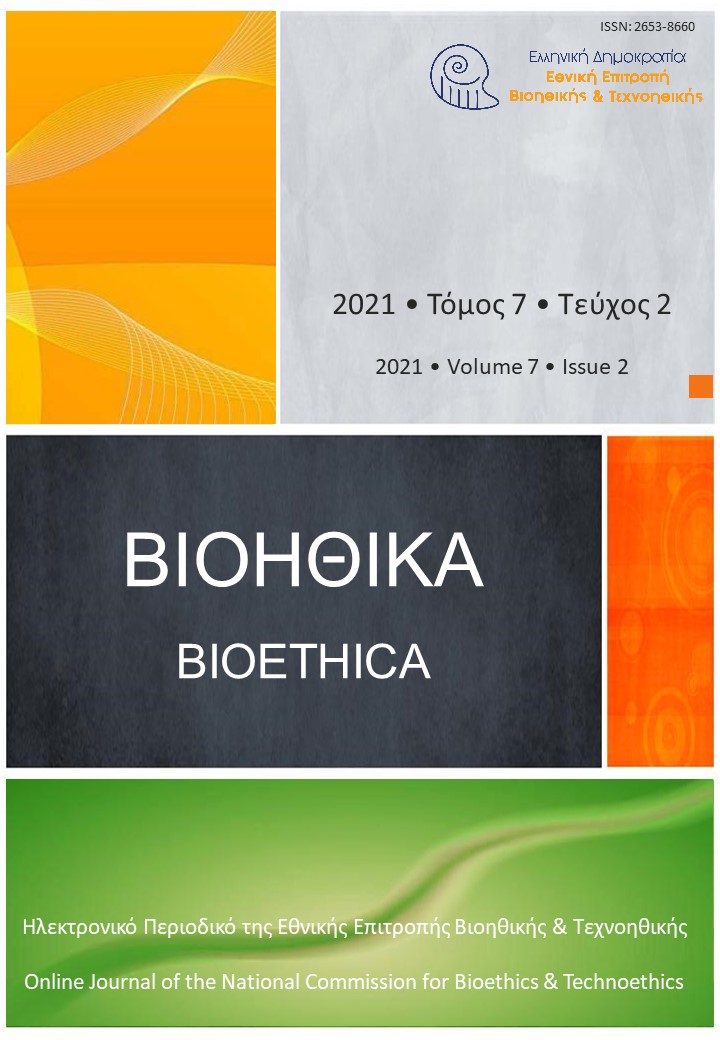Η βιοτρομοκρατία και η σύγχρονη αναγκαιότητα της βιοάμυνας
Résumé
Εισαγωγή: Η επιστημονική πρόοδος κατέστησε τον κίνδυνο ενός απρόσμενου βιοτρομοκρατικού επεισοδίου απολύτως υπαρκτό. Συνεπώς, η δημιουργία μιας ισχυρής «ασπίδας» προστασίας, η οποία είναι κοινώς γνωστή ως «βιοασφάλεια» και κατ’ επέκταση, ως «βιοάμυνα» αποτελεί μια σύγχρονη ανάγκη, συνοδευόμενη με ηθικά διλήμματα και πλείστους προβληματισμούς.
Μέθοδοι/Δεδομένα: Το ξέσπασμα της COVID–19 απέδειξε αναπόδραστα την αναγκαιότητα και η σημασία της δημιουργίας μιας ισχυρής βιοάμυνας. Τα συστήματα βιοάμυνας, τα επιτελικά σχέδια εκτάκτου ανάγκης, το risk communication, οι επαρκείς υποδομές, το εξειδικευμένο προσωπικό, τα ενδεδειγμένα μέτρα ατομικής προστασίας, οι διασφαλισμένοι οικονομικοί πόροι, η ρεαλιστική εκτίμηση κινδύνου και κυρίως τα μέσα πρόληψης, δηλαδή η αποφυγή και αποτροπή των καταστάσεων αυτών πριν εξαπλωθούν, αποτελούν πρωταρχικούς στόχους.
Αποτελέσματα: Η λεπτομερής καταγραφή των συναφών δεδομένων, θα μας βοηθήσουν να κατανοήσουμε με ένα καλύτερο τρόπο την αποτελεσματική δόμηση ισχυρών συστημάτων βιοάμυνας, και θα αναδείξουν τα ζητήματα βιοηθικής και θεσμοθέτησης, πιθανώς σε παγκόσμιο επίπεδο, με σκοπό τη δημιουργία εφοδίων και αποτελεσματικών μεθόδων αντιμετώπισης της βιοτρομοκρατίας.
Σύνοψη/Συζήτηση: Πρωταρχικός σκοπός αναδεικνύεται η κατανόηση της σημαντικότητας λήψης προστατευτικών μέτρων ενάντια στη βιοτρομοκρατία και η δημιουργία ισχυρών συστημάτων βιοάμυνας, τα οποία θα χαίρουν ευρείας επιστημονικής αποδοχής και θα στηρίζονται στην επιστημονική έρευνα και εποπτεία του φαινομένου. Τέλος, ως σημαντικό αποτρεπτικό μέσο, κρίνεται η θεσμοθέτηση κανόνων πρόληψης και αποφυγής φαινομένων βιοτρομοκρατίας, σε εθνικό αλλά και σε διεθνές επίπεδο.
Article Details
- Comment citer
-
Amasiadi, N. (2021). Η βιοτρομοκρατία και η σύγχρονη αναγκαιότητα της βιοάμυνας. Bioethica, 7(2), 24–38. https://doi.org/10.12681/bioeth.28157
- Rubrique
- Original Articles

Ce travail est disponible sous la licence Creative Commons Attribution 4.0 International .
Authors who publish with this journal agree to the following terms:
- Authors retain copyright and grant the journal right of first publication with the work simultaneously licensed under a Creative Commons Attribution CC BY 4.0 License, which allows for immediate free access to the work and permits any user to read, download, copy, distribute, print, search, or link to the full texts of articles, crawl them for indexing, pass them as data to software, or use them for any other lawful purpose. Appropriate credit must be given by citing the author(s) and the original publication in this journal.
- Authors are able to enter into separate, additional contractual arrangements for the non-exclusive distribution of the journal's published version of the work (e.g. post it to an institutional repository or publish it in a book), with an acknowledgement of its initial publication in this journal.
We encourage authors to deposit their articles, as well as data underlying the publications, in institutional and/or other appropriate subject repositories.
Bioethica permits and encourages authors to archive the final publication pdf in institutional (e.g. the repository of the National Hellenic Research Foundation) or other appropriate subject repositories (e.g. SSOAR repository for social sciences), in compliance with institutional and/or funder open access policies, after publication in the BIOETHICA. Authors must provide bibliographic details that credit publication in the journal, as well as related funding details (when applicable).
Lists of institutional and other subject-based academic open access repositories can be found listed by country at the registry http://opendoar.org/countrylist.php
If your institution does not possess a repository you may deposit a copy of your paper at no cost with www.zenodo.org , the repository supported for open access research in the EU by the European Commission, through the project OpenAIRE (www.openaire.eu )



